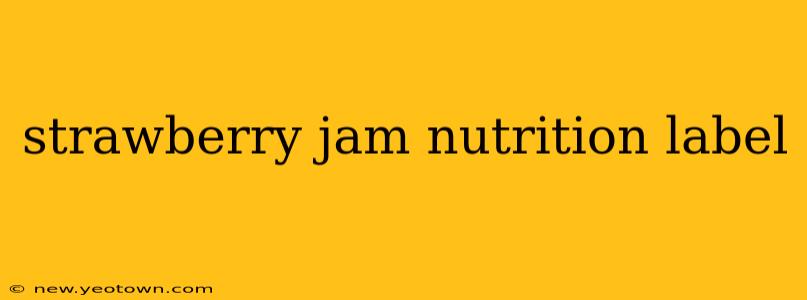Let's be honest, strawberry jam is delicious. That vibrant red, the sweet-tart burst of flavor… it's hard to resist. But before you dive spoon-first into that jar, let's take a closer look at what's actually inside, using the nutrition label as our guide. This isn't just about calories; it's about understanding the ingredients and making informed choices about what you're eating.
Imagine this: You're at the grocery store, facing a wall of jam jars. Each one promises a taste of summer, but their nutrition labels whisper different stories. How do you choose wisely? Let's unravel the mystery together.
What are the main ingredients in strawberry jam?
Typically, strawberry jam's main components are strawberries, sugar, and sometimes pectin (a natural gelling agent). The proportions vary greatly depending on the brand and the recipe. Some brands boast "low sugar" options, cleverly utilizing alternative sweeteners or adjusting the strawberry-to-sugar ratio. Others are unabashedly traditional, showcasing a richer, sweeter profile. Understanding these core ingredients is the first step to deciphering the nutrition label.
How many calories are in a serving of strawberry jam?
This is where things get interesting. A standard serving size (usually around one tablespoon) can range from 50 to 80 calories, depending on the brand and sugar content. It's crucial to check the specific label for the most accurate calorie count. Remember, those calories primarily come from sugar. More sugar means more calories.
What is the sugar content in strawberry jam?
This is often the most scrutinized part of the label. Sugar is a significant contributor to the jam's sweetness and texture. Expect to see a considerable amount of sugar grams per serving – often exceeding 10 grams. Again, "low sugar" options will have significantly lower sugar content. Pay close attention to the added sugars listed, as opposed to naturally occurring sugars in the strawberries themselves.
Does strawberry jam contain any vitamins or minerals?
While strawberries themselves are packed with Vitamin C and antioxidants, the processing involved in making jam often reduces their nutritional value. You’ll find trace amounts of vitamins and minerals, but don't rely on jam as a significant source of these nutrients. It's primarily a source of carbohydrates, namely sugar.
Is strawberry jam a good source of fiber?
The fiber content in strawberry jam is generally low. Most of the fiber present in fresh strawberries is lost during the cooking and processing of jam production. Therefore, don't consider it a significant contributor to your daily fiber intake.
Is strawberry jam suitable for diabetics?
This is a crucial question, and the answer is a cautious "no" for most diabetics. The high sugar content makes it unsuitable for regular consumption unless carefully monitored within a diabetic diet plan and in consultation with a doctor or registered dietician. Even "low-sugar" varieties should be enjoyed sparingly.
How much strawberry jam should I eat per day?
Moderation is key. Due to the high sugar content, a tablespoon or two is generally considered an acceptable limit for most people, especially if you are aiming to manage your sugar intake. It's a treat, not a staple.
What are the differences between homemade and store-bought strawberry jam?
Homemade strawberry jam often allows for greater control over the sugar content and ingredients. You can adjust sweetness and choose higher quality fruit. Store-bought jams, while convenient, may contain added preservatives and higher sugar levels. Both need to be enjoyed in moderation.
By understanding the information revealed on the nutrition label, you can make smarter choices about your strawberry jam consumption. Enjoy it as the delicious treat it is, but be mindful of its sugar content and nutritional value.

